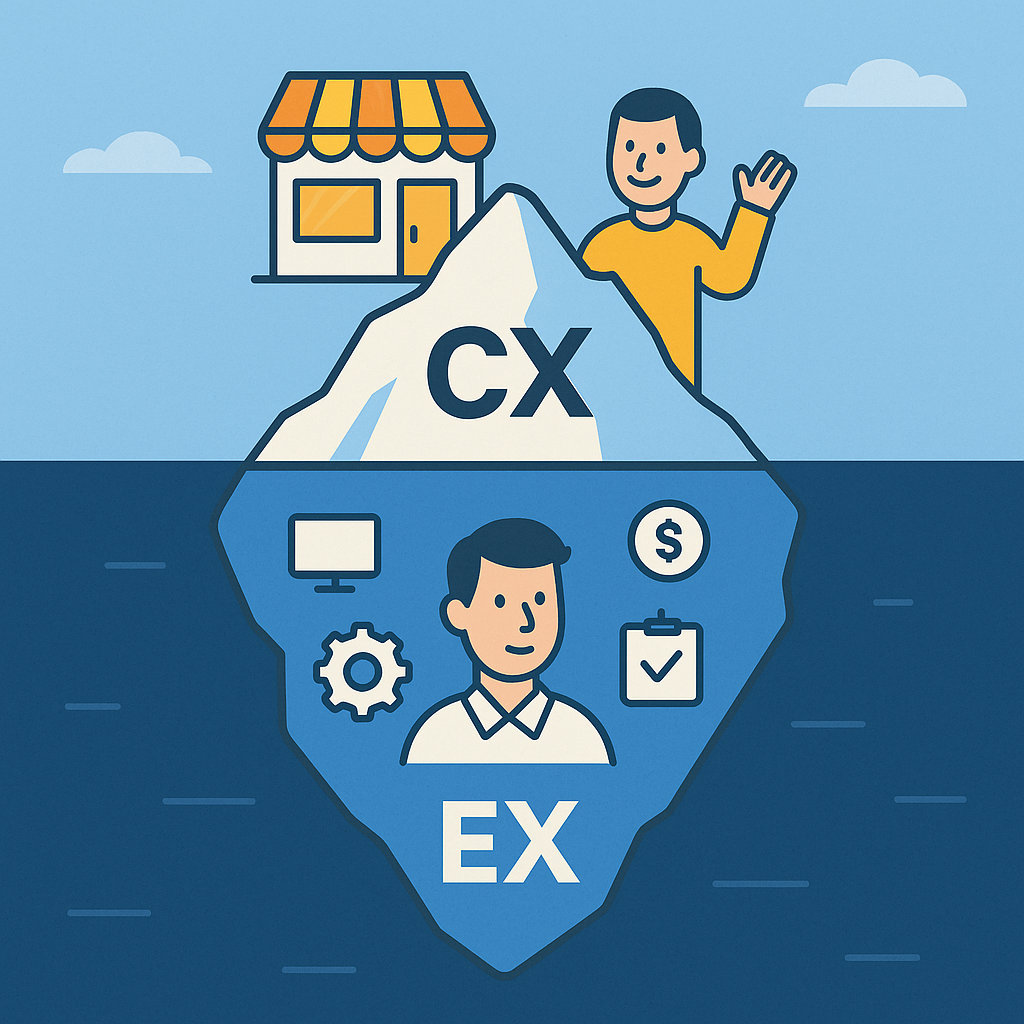After a year-long, nerve-racking project I decided to reward myself with an expensive blazer. The boutique greeted me with a pleasant scent, soft lighting, and jazz. The perfect picture collapsed when a sales associate glanced at my rumpled T-shirt and jeans and said, “The clearance section is over there.” Needless to say, I didn’t buy the blazer—priced at twice the associate’s monthly salary.
Years later, while launching the CX programme at Magnit, I recalled that moment: every investment in the customer journey is devalued if the person delivering it lives in a toxic experience. You can pour millions into scent, lighting, and merchandising, yet it all falls apart when a tired, irritable employee greets the customer.
EX → CX: Economics, Not Romance
The business value of Employee Experience (EX) has long been converted into numbers:
- MIT CISR found that top-quartile EX companies deliver 2× more innovation, 2× higher customer satisfaction, and +25 % profit versus industry peers.
- A 2024 Gallup meta-analysis shows highly engaged teams generate +23 % profitability, +18 % productivity, and −21 % turnover compared with low-engagement teams.
- Willis Towers Watson reported that across 50 firms, higher engagement added +19 % operating profit within 12 months.
Whether you track NPS, CSAT, or CES, the metric must be stable, collected consistently, and linked to money. EX is the lever that moves any of them. What was once “HR romance” is now a direct financial metric.
No Data — No Action
Any change—shift schedules or in-house gamification—runs through four cycles:
- Diagnostics: interviews, shift diaries, shadowing, HR analytics.
- Pain prioritisation: map frequency versus impact on CSAT or revenue.
- Pilot & control: measure who performs better—test group or “next-door” group.
- Roll-out & open dashboard: if data aren’t visible to everyone, the process will regress.
Just as we no longer redesign a site without usability tests, we don’t change incentives without an A/B approach.
Anatomy of Employee Experience: Six Layers of Influence
- Leadership: trust, feedback, licence to fail safely.
- Team climate: psychological safety, support rituals.
- Internal service culture: functions serve each other as well as the front line serves the customer.
- Employee journey: every stage—from hiring to exit—mapped as thoroughly as a CJM.
- Motivation & recognition: service KPIs weigh no less than shrinkage KPIs; quick non-monetary rewards complement long-term bonuses.
- Digital workplace: systems and processes remove, not add, friction.
Shift one layer and CX metrics move; for reliable impact, address all six in parallel.
Large-Scale Retail Case (Across the Six Layers)
| Layer | What Went Wrong | How It Works When Done Right |
|---|---|---|
| 1. Leadership | Punishment trumps root-cause analysis. | Ask “Where did it break and who will fix it?” instead of “Who’s to blame?” |
| 2. Team | Managers charge loss shrink to floor staff, creating a toxic environment—even a “mafia” culture. | Losses are managed by tools, not fines; transparency eliminates scapegoating. |
| 3. Internal service | IT delays tickets, logistics delivers late, prices change mid-day—front line loses face. | End-to-end SLAs and service re-engineering protect the salesperson in front of customers. |
| 4. Employee journey | Management has no idea what the salesperson confronts daily. | Journey mapping surfaces bottlenecks before they hurt service. |
| 5. Motivation | Salesperson sees KPIs only on payday: focus is “avoid loss,” not “delight guests.” | Service KPIs baked into daily routines and directly tied to income. |
| 6. Digital workplace | Clunky, unstable systems: “We don’t pay them to be comfy.” | Intuitive pro interfaces and streamlined processes are table stakes for client care. |
Practical Algorithm “EX → CX”
- Map the employee journey. Emotional drop-offs for staff mirror service potholes.
- Quantify irritants. Know exactly where and what hurts.
- Link to customer metrics. No revenue tie-in? Park the fix, chase a costlier pain.
- Remove back-office blockers. SLAs, tools, schedules—anything that eases chronic fatigue.
- Re-wire motivation. If service KPIs don’t pay staff, CX won’t improve.
- Cultivate internal service. Publish a monthly internal CSAT: who helped, who hindered.
- Train “in the moment.” Micro-learning, peer-to-peer, gamification—knowledge must translate to action instantly.
- Listen continuously. Pulse surveys and a hotline flag issues before complaints hit social media.
- Show the impact. “We killed mid-day price changes—complaints dropped by 35 %.”
ROI Formula Reversed
“Let’s boost sales first, then fix the staff experience” never works. For every dollar invested in CX design to pay back, a significant share must go to removing internal irritants.
EX directly drives EBITDA by increasing productivity, cutting attrition, and lowering the cost of error correction.
Bottom Line
EX isn’t “another HR initiative”—it’s the infrastructure of competitive advantage. Fix employee irritants and you automatically enhance customer experience because there are no leaks in the value chain. CX and EX are one circuit: start the loop with a satisfied, equipped, and recognised employee, and you’ll end it with a satisfied customer.

